Abstract:
We applied D-InSAR(Differential SAR Interferometry) at the Sakurajima region, one of the most active volcanoes in Japan, where leveling surveys and GPS measurements have been carried out. These terrestorial methods, however, can detect only deformation at several points on the surface. While the SAR technology is an Imaging Rader and can detect areal distribution of deformations simultaneously. Therefore our result will be effective to interpolate past terrestrial studies.
In this study, we selected 12 pairs from JERS-1 SAR(L-Band) data during 1992-1998, and obtained deformation map. Because obervation date of these pairs overlap on epochs, we estimated the deformation using least square adjustment. The result shows good agreement with that of GPS. This fact indicates that the D-InSAR technique is effective to investigate crustal deformations related to volcanic activity. We attempted to explain those deformations by employing Mogi-Model. Finally we estimated changes in volume of magma reservoirs by employing Mogi-Model parameters.
|
1. はじめに
桜島の北方にある鹿児島湾は姶良カルデラと呼ばれ、2万数千年前の巨大噴火によって形成された直径約20kmの窪地である。桜島はこの姶良カルデラの南縁に位置し,現在も活発に活動している。姶良カルデラ周辺域では地下のマグマ溜りの膨張・収縮による地殻変動が観測されており、1914年の噴火後には鹿児島湾を中心とした広範囲での沈降が観測されている。最近20年間の桜島島内の比高変化を見ると、1993年頃を境に沈降から隆起へと活動が変化しており、これは次の活動の準備段階に入ったと解釈されている(石原,1999)。
本研究ではJERS-1 SARの1992年から1998年までの複数のデータを用い、2pass D-InSARによる桜島と姶良カルデラ周辺域の地殻変動の検出を試み、得られた変動を最小2乗法により時系列に変換した上でGPSによる結果と比較した。また各画像について茂木モデルによる変動のシミュレーションを行い、推定されたパラメータから膨張源の体積変化を求めた。
2. 手法
今回使用したのは以下の12ペアである(Fig.1)。選考基準は、1)干渉性の問題から、空間基線がなるべく短いこと、2)予想される地殻変動があまり大きくないことから、時間基線がなるべく長いこと、の2つである。解析には国土地理院のGSISARを用いた。
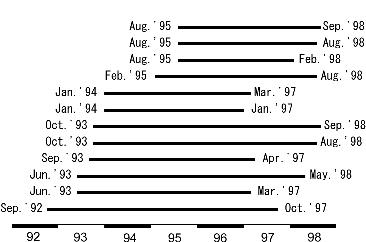
Fig.1 observation date of pairs we used.
|
3. 地殻変動の検出
解析の結果、ほぼ全てのペアにおいて桜島北部に隆起を表すフリンジパターンが見られた。また桜島東部の黒神付近には局所的な沈降が見られる。そして一部の画像には、鹿児島湾対岸の国分市周辺にも隆起を表すフリンジパターンが見られ、鹿児島湾地下に膨張源があることを示唆するものとして興味深い(Fig.2)。
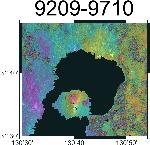
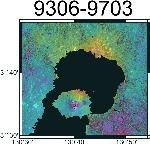
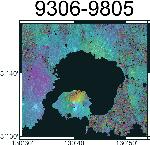
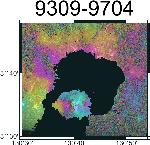
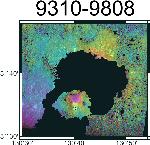
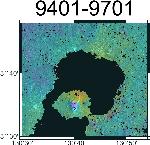
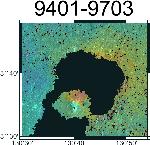
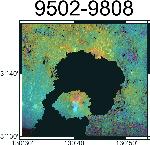
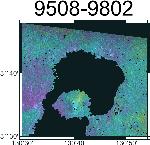
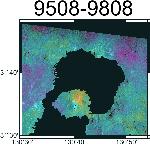
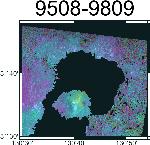

Fig.2 Obtained deformation maps. cyan-to-yellow change indicates deformation to the satellite, which means upheaval if deformation is vertical.
|
4. 変動量の時系列
得られた変動量は2回の観測の間の変動量であり、ある一定の時点を基準としたものではない。そこで本研究ではこれらの観測期間の重なりあった相対的な変動量を、各年の変動率を一定と仮定し、最小2乗法を用いて推定することで一定の時点を基準としたものに変換した。すなわち、ある点のi年の変動率をXi[cm/yr]とすると92年9月-97年10月のペアの変動量は、

と書くことができる。X92-X98の未知数7個に対し式が12個のペアについて1本ずつ立てられるので、最小2乗法によりこれらを推定できる。
こうして得られた各年の変動率を累積することで求められた、桜島西部に対する桜島北部の変動量の時系列をFig.3に示した。なおこれは92年1月を基準とした時の変動量である。
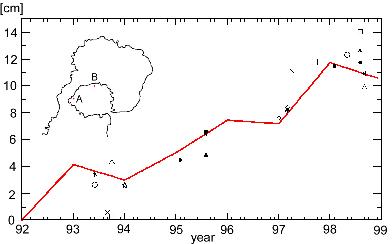
Fig.3 Time series of deformation at B (northern part of Sakurajima) referencing to A (western part) derived from least square adjustment. Phase changes are converted into vertical deformation assuming deformation is vertical. Each marks (+, o, etc.) correspond to deformations in interferograms.
|
Fig.4は京都大学防災研究所付属火山活動研究センターによる桜島島内のGPS観測点の比高変化であり、96-97年に一度変動が停滞する点や変動量等、SARによる結果と良い一致を示している。
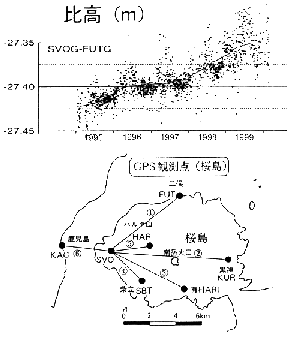
Fig.4 Height change at FUT station(northern part in Sakurajima) relative to SVO station(western part) by GPS. Baseline is shown in map. (Sakurajima Volcano Research Center DPRI Kyoto Univ.,2000)
|
5. 茂木モデル
各ペアについて茂木モデルにより予想される変動パターンをシミュレートし、干渉画像と比較した。シミュレートの際には2つの膨張源−鹿児島湾内地下10kmと桜島直下4km−を仮定し、SARによる結果との差が最小になる直上隆起量を推定した。Fig.5に94019703、95089808の場合についての干渉画像、シミュレート画像、そしてその2つの残差を示す。シミュレート画像と実際の干渉画像は良い一致を示し、残差画像もほぼ単一位相となっているのがわかる。
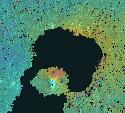 |
- |
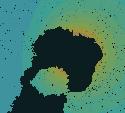 |
= |
 |
| Interferogram |
| Simulated |
| Difference |
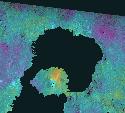 |
- |
 |
= |
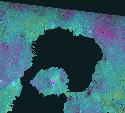 |
Fig.4 Interferogram, simulated image, and the difference. We assumed inflating source at 10km(top:94019703) and 4km(bottom:95089808) deep from white "+" in simulated image and calculated the maximum upheaval at white "+" (Uz0). Calculated Uz0 is 8.8cm for 94019703 pair, and 5.4cm for for 95089808 pair.
|
さらに推定された直上隆起量と江頭他, 1997の式
dV = 1.33π × Uz0 × d2
から膨張源の変形容積dVを計算し、変動量の場合と同様の手法により時系列を求めた(Fig.5)。
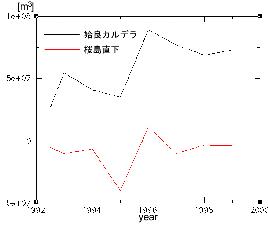
Fig.5 Obtained Volume change of magma reservoir under Kagoshima bay(Aira cardera) and Sakurajima.
|
6. まとめ
本研究では、L-Bandを用いたD-InSAR技術による火山性地殻変動検出のモデルケースとして桜島及び姶良カルデラ周辺域の地殻変動の検出を試み、それに成功した。これまで得られた水準測量、GPS等の点ごとの観測データに加えて、SARにより火山性地殻変動の面的な変動分布が得られた意義は大きい。また最小2乗法により変動の時系列を求め、GPSによるデータと比較した結果、変動の大きさ、傾向共に良い一致を示した。したがってSARから得られた変動量が信頼するに足るものであると考えられる。そこでこの結果に茂木モデルを適用し、膨張源のパラメータを推定し、変動の場合と同様の手法により膨張源の体積変化の時系列を得ることができた。今後D-InSARを火山性地殻変動の研究に用いることがきわめて有効であることが明らかにされた。
参考文献:
Goldstein, R.M., H.A.Zebker and C.L.Werner(1988): Satellite radar interferometry: Two-dimensional phase unwrapping, Radio Sci., 23,713-720
Massonet, D., M.Rossi, C.Carmona, F.Adragna, G.Peltzer, K.Feigl and T.Rabaute(1993): The displacement field of the Landers earthquake mapped by radar interferometry, Nature,364,138-142
Rosen, P.A., S.Hensley, H.A.Zebker, F.H.Webb and E.J.Fielding(1996): Surface deformation and coherence measurements of Kilauea volcano, Hawaii, from SIR-C radar interferometry, J. Gosphys. Res., 101, 23109-23125
Tobita, M., S.Fujiwara, S.Ozawa, P.A.Rosen, E.J.Fielding, C.L.Welner, Mas.Murakami, H.Nakagawa, K.Nitta and Mak.Murakami (1998):Deformation of the 1995 North Sakhalin earthquake detected by JERS-1/SAR interferometry, Earth, Planets and Space, 50, 313-325
Beauducel F. and P.Briole(2000):Volcano-wide fringes in ERS synthetic aperture rader interferograms of Etna(1992-1998): Deformation or tropospheric effect?, J. Geophys. Sci., 105, 16391-16402
江頭庸夫, 高山鐵朗, 山本圭吾, M.Hendrasto, 味喜大介, 園田忠臣, 松島健, 内田和也, 八木原寛, 王彦賓, 木股文昭, 宮島力雄, 小林和典(1997):姶良カルデラの地盤の再隆起-1991年12月〜1996年10月-,京都大学防災研究所年報, 40 B-1,49-60
山科 健一郎(1986):応力場と火山噴火,火山,第2集第30巻,S101-S199
石原 和弘, 坂元 隼雄(1999):桜島火山の火山活動, 桜島火山の地下水・熱水系に関する研究,京都大学防災研究所共同研究 9P-5
京都大学防災研究所付属火山活動研究センター(2000) 第85回火山噴火予知連絡会資料
|
|






















